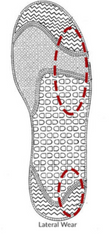Feet Pain when You Run? Your Old Running Shoes Might Have the Answer to Why
Jan 03,2023 | Marketing Sunnystep
The way your feet land when you run can affect the pressure placed on your feet, and can be a potential source of injuries on several muscles like your Achilles tendon or cause other foot pain in the long run. Take out an old pair of running shoes and observe the wear and tear on the bottom of your shoes — could your feet be landing wrongly? Here’s how you can find out whether your gait is normal or not.
Wear on The Middle Sections of Your Sole
How it looks: Wear on the heel and the forefoot area to the big toe and second toe.
If your gait resembles this, congratulations! This gait has the best shock absorption capability because your heel lands first before rolling inwards to your forefoot, distributing the shock of the impact across a wider area. This is the way a normal gait should look, and the risk of injuries are minimal.
Wear Towards the Inner Side of Your Sole
If the wear of your shoes look like this, it’s likely that your feet lean inwards excessively and your arch is either over-flattened or you may have a condition called flat feet. This reduces the capability of your feet to absorb shock and puts more pressure on the inner side of your sole. This is known as overpronation, and is common among people with flat feet.
The pressure on your inner sole can increase if your shoes do not come with proper arch support, and encourage the development of a bony bump on the first joint of your big toe. This is known as a bunion, which can be painful.
Wear On The Outer Side Of Your Sole
Wear on the outside of your sole indicates that you under pronate, which means your feet roll outwards instead of inwards and pressure is concentrated on the outer edge of your foot. This is common among people with excessively high arches.
This type of gait places excessive stress on your ankles, and increases the risk of ankle sprains. Instead of a bunion, a bony bump known as a bunionette can also form on the first joint of your pinky toe as a result of the constant pressure, causing more foot pain.
What Next?
Now that you know what your worn shoes tell you about your gait and more importantly foot structure, what should you do next? Consider wearing comfortable shoes when doing exercises like running or better yet, for your daily activities, with enough space in the front to avoid foot pain caused by bunions. Perhaps invest in arch support insoles so that your overpronate or under pronate feet can be shaped properly to improve your gait. Observing the wear and tear of your shoes should only provide a guideline to help you decide if you may be overdue for an appointment with a podiatrist or orthopedist, who would be able to provide further advice to help you obtain an optimal gait.




